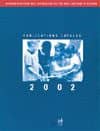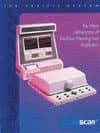One of the greatest challenges for the dispensing professionals is to be able to successfully fit patients who have Temporomandibular Joint (TMJ) syndrome or patients who have abnormally large movements of the TMJ that affect the dynamic ear canal. TMJ syndrome is characterized by limited movement of the jaw (ie, being unable to fully open mouth) and clicking sounds when chewing. Tinnitus, pain, and even deafness have been associated with TMJ syndrome; therefore, when this condition presents to dispensing professionals, the patient should be referred to a dentist or physician. Causes of TMJ syndrome can range from lesions of the TMJ tissues, overbite or malocclusion, to poorly fitting dentures. Griffing et al.1 have provided an excellent overview of TMJ movements and Temporomandibular Disorders (TMD) as it relates to hearing care professionals.
In a more general sense, movement of the temporomandibular joint—whether associated with TMJ syndrome or not— can make hearing aid fittings extremely challenging. There are a number of signs that indicate to hearing care clinicians that they are dealing with a patient who may have a problematic TMJ relative to their hearing aid fitting. One indication is when the clinician, with his/her small finger (the pinky) inserted in the patient’s canal, is able to detect unusually large movements of the canal wall (usually in one ear) when the patient’s mouth opens and closes. The most telling TMJ clue is when a patient fit with a hearing aid reports problematic movement of the earpiece. If the problem is significant, the seal will break when the patient talks, chews, or opens his/her mouth. Often, the earpiece will “walk itself out” of the ear canal.
When a patient has excessive canal movement associated with the TMJ and movement within the ear canal, the need for maintaining a good seal is in direct proportion to the severity of hearing loss. The greater the hearing loss, the more gain the patient needs. Consequently, the more gain the patient needs, the greater likelihood of feedback when the earpiece loses its seal.
The problem of TMJ-related disorders and earpieces has been a problem in the hearing device fitting arena since the advent of hearing aids that utilize earpieces. This problem has become even more prevalent since the introduction of custom in-the-ear (ITE) hearing devices and especially the smaller completely-in-the-canal (CIC) devices. The number or percentage of hearing aid patients with TMJ problems so pronounced that their dispensing professionals have difficulty obtaining and maintaining a good ear canal seal is not known. It is likely, however, that this population is relatively small.
However, as a clinician with 30 years of experience, I have observed that patients with TMJ problems represent a large enough group so that they occupy many hours of frustration for the clinician who—usually by trial and error—attempts to procure an adequate-sealing earpiece. Occasionally, counseling can convince the patient to use a full-shell ITE or behind-the-ear (BTE) device that offers greater potential for solving this problem. However, as with the general patient population, these patients will often insist on wearing only CIC models, the least noticeable hearing devices. Because CIC devices can lead to the greatest problems in obtaining an adequate seal, these patients often feel they are forced to make compromises in their treatment: Either they have to accept a device that only provides a proportion of the desired gain, or they have to reject amplification altogether because of the frustration they have experienced in having to return to the clinic so often to have the device modified or re-cased.
The relationship of the TMJ and adequate earpiece fitting has been widely discussed in many industry circles. Numerous solutions have been offered for addressing this problem. Griffing,1 in a discussion of TMJ, TMD, and hearing device fitting, suggests that TMJ patients be referred to a dentist familiar with treating TMJ before the clinician attempts a hearing aid fitting. One of the most common suggestions for fitting TMJ patients is the use of long earpieces that extend beyond the second bend into the bony portion of the ear canal. Although this solution appears to have a great deal of merit, the bony portion of the ear canal is very thin and frequently leads to patient complaints of soreness and discomfort.
Additionally, the shape of the earpiece and material that is most frequently used to fabricate long earpieces are also problematic. The length of earpieces, even in small CIC devices, is such that patients complain that they cannot insert them beyond the second bend of the ear canal. If soft material is used, the patient often complains that the material collapses when they are trying to insert the earpiece.
Macrae2 compared soft versus hard earpieces in terms of the ability of these materials to maintain an effective seal. Ironically, he observed that, when earpieces were used that fit the entire length of the canal wall, the hard material maintained a better seal. An additional problem in using an earmold or device that fits the length of the canal is that patients frequently complain of the feeling that their ear is stuffed with a wad of material (ie, occlusion effect).
Addressing TMJ/TMD Problems with New Device
A hearing device recently introduced by SeboTek Hearing Systems, the Post Auricular Canal (PAC), is designed to avoid many problems of previous deep canal fittings.3 Because of its design, most patients with TMJ problems can wear it without the device losing its seal or “walking out of the canal.” The result is that a patient can wear it comfortably at a gain level that is adequate for their needs.

Figure 1. The SeboTek PAC hearing instrument modular design incorporates a speaker4 assembly (receiver and fitting tip) that is designed to provide for deep canal insertion.
The PAC consists of a canal receiver and a miniature processor which are coupled via a translucent wire (Figure 1). It is designed to be cosmetically unobtrusive, and yet it also eliminates many of the inherent problems of the smallest, custom hearing instruments. The PAC uses patented, surgical-grade silicone ear tips that fit over the modular receiver. The ear tips are short enough that they can be inserted beyond the second bend of the ear canal much easier than a conventional earmold or CIC device. The speaker link/receiver assembly comes in three different lengths.

Cosmetically, the PAC is at least as visually pleasing as a CIC because of way the receiver/earhook assembly has been designed (Figure 2). The translucent tube is so thin that, when it is worn with the small post-auricular device, it is essentially unnoticeable. The ear tips come in seven different sizes, and the device can fit a wide range of hearing losses up to 70dB HL.
The ear tips of this device overcome most of the problems related to the occlusion effect because the soft, silicone tip occupies only a small portion of the canal. The patented ear tips were developed to have a consistency and shape that affords a tight seal without the discomfort or soreness typically found in traditional, deep-fitting earpieces. The shape and design of the silicone ear tip is such that only a small portion of the tip rests against the ear canal. The ear tip has the appearance of an umbrella: as the flanged portion of the tip extends from the mid-point to the edge, it gradually becomes thinner, therefore reducing the feeling of an object pushing against the ear canal.

Clinical Experience
Of the thousands of PAC style instruments that have been fit, most patients with TMJ-related problems have no difficulty wearing it comfortably and maintaining a tight seal. For example, the patient in Figure 3 had tried to wear hearing devices for 34 years. He would not accept any device that he felt was cosmetically noticeable. As is obvious from his audiogram, the severity of his hearing loss nearly disqualifies him from being a candidate for the PAC device. However, looking at his unaided and aided test scores for his previous device versus the PAC, a substantial improvement is seen with the PAC. He is now able to obtain 10 dB to 20 dB greater use gain with the PAC because higher gain without feedback can be obtained compared to his previous device.
Similarly, at least 5 other patients encountered by the author in recent clinical experience had similar TMJ-related earmold problems, and the aided thresholds for the PAC device revealed that these patients received gain benefit within an acceptable range. Upon wearing the device, each of these patients reported that they did not have problems with ear tip slippage or the devices “walking out of their ear.” More importantly, after a few days of adaptation, they reported the tip was so comfortable that they forgot it was in their ear. These 5 patients represent only a small population of those with TMJ-related difficulty that have been successfully fit with PAC device. While more study is probably warranted, there is clear evidence supporting the proposition that PAC-style hearing instruments provide the clinician with a device that can be used to successfully fit this patient population.
Discussion
The PAC system, with its modular design and silicone ear tips, offers the clinician a device that they can fit during the initial visit and provide even the most discriminating patient with a cosmetically pleasing hearing device. The receiver, speaker link, and ear tip can be quickly and easily replaced in the clinic. Further, the processor has a variety of features that can be programmed to meets the needs of a wide range of patients. The programming flexibility of the PAC system ranges from Wide Dynamic Range Compression (WDRC) to full, linear processing. Furthermore, independent programming is offered for the gain, MPO, compression parameters (including compression kneepoint), crossover frequency for each of the 4 memories, 4 channels and bands, as well the directional microphone and the telephone memory.
The methods used in fabricating earmolds and custom ear devices have been in use for many years. As discussed in this article, conventional fabrication has several inherent problems. One of the major problems is that the characteristics of an individual patient’s ear canal cannot always be communicated via an impression. Some patients have very firm, cartilaginous ear canals while others have will have a canal where one portion is very firm and another, extremely soft.4,5
Another inherent problem with fabricated ear pieces is that time is lost in the fitting process waiting for the earpiece to be made. With the PAC, this time can be spent counseling the patient in the use of amplification and making the appropriate adjustments in the software to serve the patient’s everyday needs. For dispensing professionals dealing with patients who have TMJ-related fitting problems, the time and effort spent trying to balance a comfortable earpiece with an adequate seal can be very demanding when using conventional earmold fabrication. The PAC silicone ear tips overcome most of these inherent problems. The patient can be fit with a deep canal fitting that is both comfortable and does not lose its seal. This feature ultimately leads to a more satisfied patient that can wear a comfortable hearing device with the appropriate level of amplification that they need.
Summary
A new style hearing device, a Post Auricular Canal (PAC) instrument, has the potential to assist clinicians in fitting patients with TMJ-related problems. Because of the unique shape and texture of the silicone ear tip and the fact this tip is designed to be deeply seated in the bony portion of the ear canal, patients can wear this device without it working free from the canal or losing the critical ear canal seal.
References
1. Griffing TS, Giles GE, Romriell D. Relationship of TMJ & TMD to successful CIC fittings. Hearing Review. 1998; 4(5):14-18.
2. McRae J. Static pressure seal of earmolds. J Rehab Res Dev. 1990; 27(4):397-410.
3. Staab W. Solving the occlusion effect. Hearing Review. 2003; 10(9):46-48, 63.
4. Oliveira R. The dynamic ear canal. In Ballachanda BB, ed. The Human Ear Canal. San Diego: Singular Publishing Group Inc; 1997:83-111.
5. Pirzanski C, Berge B. Earmold impressions: Does it matter how they are taken? Hearing Review. 2003; 10(4):18-20,80.




